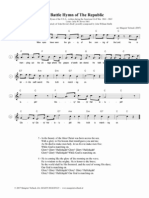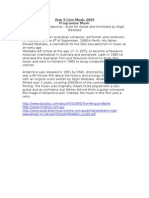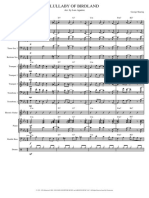0 ratings0% found this document useful (0 votes)
217 viewsEduqas Ko Badinerie
Eduqas Ko Badinerie
Uploaded by
J FrancisThe Badinerie by JS Bach is in binary form with two repeated sections. Section A is in B minor and modulates through various keys to end in the dominant minor, while Section B begins in the dominant minor and modulates through other keys to return to the tonic of B minor. The piece is scored for flute, string orchestra and harpsichord and features two short melodic motifs along with typical Baroque ornaments and compositional devices. It has a lively Allegro tempo in simple duple meter.
Copyright:
© All Rights Reserved
Available Formats
Download as PDF, TXT or read online from Scribd
Eduqas Ko Badinerie
Eduqas Ko Badinerie
Uploaded by
J Francis0 ratings0% found this document useful (0 votes)
217 views1 pageThe Badinerie by JS Bach is in binary form with two repeated sections. Section A is in B minor and modulates through various keys to end in the dominant minor, while Section B begins in the dominant minor and modulates through other keys to return to the tonic of B minor. The piece is scored for flute, string orchestra and harpsichord and features two short melodic motifs along with typical Baroque ornaments and compositional devices. It has a lively Allegro tempo in simple duple meter.
Original Title
eduqas-ko-badinerie
Copyright
© © All Rights Reserved
Available Formats
PDF, TXT or read online from Scribd
Share this document
Did you find this document useful?
Is this content inappropriate?
The Badinerie by JS Bach is in binary form with two repeated sections. Section A is in B minor and modulates through various keys to end in the dominant minor, while Section B begins in the dominant minor and modulates through other keys to return to the tonic of B minor. The piece is scored for flute, string orchestra and harpsichord and features two short melodic motifs along with typical Baroque ornaments and compositional devices. It has a lively Allegro tempo in simple duple meter.
Copyright:
© All Rights Reserved
Available Formats
Download as PDF, TXT or read online from Scribd
Download as pdf or txt
0 ratings0% found this document useful (0 votes)
217 views1 pageEduqas Ko Badinerie
Eduqas Ko Badinerie
Uploaded by
J FrancisThe Badinerie by JS Bach is in binary form with two repeated sections. Section A is in B minor and modulates through various keys to end in the dominant minor, while Section B begins in the dominant minor and modulates through other keys to return to the tonic of B minor. The piece is scored for flute, string orchestra and harpsichord and features two short melodic motifs along with typical Baroque ornaments and compositional devices. It has a lively Allegro tempo in simple duple meter.
Copyright:
© All Rights Reserved
Available Formats
Download as PDF, TXT or read online from Scribd
Download as pdf or txt
You are on page 1of 1
JS Bach: Badinerie
Form and structure: Harmony: Melody:
The piece is in Binary form (AB). Diatonic; mixture of root position and inverted chords; The movement is based on two musical motifs.
Section A is 16 bars long. uses V7 chords and a Neapolitan sixth chord.
Section B is 24 bars long. Imperfect and perfect cadences are clearly presented
throughout. Both sections end with a perfect cadence.
Each section is repeated (AABB).
Dynamics: Metre and rhythm:
Mostly forte throughout, although no Simple duple time – 2/4 – with two crotchet beats in
markings appear on the score. every bar.
On some recordings, terraced dynamics Uses ostinato rhythms which form the basis of two
(sudden changes) are included. short musical ideas (X and Y), consisting almost totally of
quavers and semi-quavers.
Both motifs begin with an anacrusis. Motif X is entirely disjunct
Background details: Instrumentation:
whilst motif Y combines disjunct and conjunct movement.
Composed by Johann Sebastian Bach (1685 Flute, string orchestra and harpsichord.
– 1750), one of the main composers of the Typical ornaments and compositional devices of the period are
The score has five parts (flute, violin 1, violin 2, viola and used including trills, appoggiaturas and sequences.
Baroque era in music. cello). The harpsichord player reads from the cello line
Badinerie is the last of seven movements from and plays the notes with their left hand whilst filling in the
a larger piece called Orchestral Suite No.2. chords with their right hand.
Texture:
The piece was composed between 1738-1739.
Homophonic: melody and accompaniment.
The flute and cello provide the main musical material; however, the 1st
Tonality: violin participates occasionally.
Section A begins in B minor (tonic) and ends in F# minor (dominant minor). The 2nd violin and viola provide harmony with less busy musical lines.
Section B begins in F# minor (dominant minor) and ends in B minor (tonic).
Section A modulates from B minor through A major before arriving at F# minor.
Tempo:
Section B modulates from F# minor through E minor, D major, G major and D major before arriving at B The tempo is Allegro (quick, lively, bright), although not marked on
minor. the score.
You might also like
- Celebrate Theory: Level 7 WorksheetsDocument32 pagesCelebrate Theory: Level 7 WorksheetsDanielle Yi100% (1)
- Gerald Barry Piano Quartet No. 1Document3 pagesGerald Barry Piano Quartet No. 1arankelleher142No ratings yet
- BATMAN THEME (From The Original Television Series) : R - T° I: ....... ,,irr T Irr I RR R IDocument8 pagesBATMAN THEME (From The Original Television Series) : R - T° I: ....... ,,irr T Irr I RR R IFabiano OliveiraNo ratings yet
- Alla Rustica - PartsDocument12 pagesAlla Rustica - PartsRael GobattoNo ratings yet
- Pas Redouble Full Score Part 2Document8 pagesPas Redouble Full Score Part 2Dagga DiggerNo ratings yet
- Teachers Pet Acordes - School of RockDocument3 pagesTeachers Pet Acordes - School of RockVladimir Zárate GayossoNo ratings yet
- Year 9 Minimalism SOWDocument25 pagesYear 9 Minimalism SOWBlake HarrisNo ratings yet
- Bradbury, Ray - Another Fine MessDocument8 pagesBradbury, Ray - Another Fine Messpicchetts100% (1)
- Jonas Braasch - A Cybernetic Model Approach For Free Jazz ImprovisationsDocument11 pagesJonas Braasch - A Cybernetic Model Approach For Free Jazz ImprovisationsJohn Sandham100% (1)
- Mozart Requiem - BookletDocument11 pagesMozart Requiem - BookletLobo EsteparioNo ratings yet
- Analysis On Alla HornpipeDocument1 pageAnalysis On Alla HornpipeChan VirginiaNo ratings yet
- Beethoven Choral FantasyDocument11 pagesBeethoven Choral FantasyRay ChanNo ratings yet
- Bhangra PresentationDocument23 pagesBhangra PresentationCath Thomas100% (1)
- AMUSA General KnowledgeDocument8 pagesAMUSA General KnowledgeCameron RobertsonNo ratings yet
- Y13 Lesson 2 Vivaldi - Concerto in D Minor, Op AnalysisDocument13 pagesY13 Lesson 2 Vivaldi - Concerto in D Minor, Op AnalysisWilliam WantNo ratings yet
- Teachers Notes - Eduqas - London Symphony - Movement - 1Document21 pagesTeachers Notes - Eduqas - London Symphony - Movement - 1Alan PerrinNo ratings yet
- Y9 Minimalism (MUW)Document30 pagesY9 Minimalism (MUW)Zenan KWAN100% (1)
- MT0817 Scheme KS5 Bachs CantataDocument9 pagesMT0817 Scheme KS5 Bachs CantataTracy LegassickNo ratings yet
- Faust SymphonyDocument5 pagesFaust SymphonyAnonymous J5vpGuNo ratings yet
- Abrahams CPME Best PracticesDocument9 pagesAbrahams CPME Best PracticesenchufenchufadosNo ratings yet
- MT0317 Scheme KS5 Jazz Primer Part 1Document11 pagesMT0317 Scheme KS5 Jazz Primer Part 1Tracy LegassickNo ratings yet
- Holst - The PlanetsDocument3 pagesHolst - The PlanetsLionel J. LewisNo ratings yet
- Rhythm Clock PDFDocument2 pagesRhythm Clock PDFEvandro EliasNo ratings yet
- Schopenhauer and Rossinian Universality On The Italianate in SCHDocument22 pagesSchopenhauer and Rossinian Universality On The Italianate in SCHDBA Murialdo100% (1)
- Hal Leonard Digital BookDocument1 pageHal Leonard Digital BookmusicaNo ratings yet
- Capercaillie Fact SheetDocument2 pagesCapercaillie Fact Sheetapi-328875934No ratings yet
- Topolewski Errata AnalysisDocument7 pagesTopolewski Errata AnalysisAndrew JanesNo ratings yet
- Analysis of Carl Vine's Percussion SymphonyDocument2 pagesAnalysis of Carl Vine's Percussion SymphonyJack Clay100% (1)
- The Cuckoo and Nightingale in Music PDFDocument18 pagesThe Cuckoo and Nightingale in Music PDFxNo ratings yet
- GCSE Music Revise Guide 2016Document48 pagesGCSE Music Revise Guide 2016Chris PowellNo ratings yet
- Rhythm Book - BMSDocument34 pagesRhythm Book - BMSJose Munoz-MontanoNo ratings yet
- Musical Theatre Revision Guide - Rodgers and HammersteinDocument3 pagesMusical Theatre Revision Guide - Rodgers and HammersteinChris Powell0% (1)
- Bernstein Set Work IntroDocument12 pagesBernstein Set Work IntroMrPughTheMusicManNo ratings yet
- Susato BD1 Recorders ScoreDocument2 pagesSusato BD1 Recorders Scoremariasara111No ratings yet
- Chanukah JoyDocument26 pagesChanukah JoyMarcos Antonio MachadoNo ratings yet
- Review of Hedwigs ThemeDocument8 pagesReview of Hedwigs ThemejessNo ratings yet
- Complete Repertoire ListDocument6 pagesComplete Repertoire Listapi-371683416No ratings yet
- Music Revision Booklet PDFDocument32 pagesMusic Revision Booklet PDFMr S LawrensonNo ratings yet
- Piano g6 2021 2022 Rev Sep 2020Document12 pagesPiano g6 2021 2022 Rev Sep 2020Iqhwan CaesarNo ratings yet
- Delibes Flower DuetDocument4 pagesDelibes Flower DuetEmanueleNo ratings yet
- Booklet PDFDocument12 pagesBooklet PDFKeith Pittman100% (1)
- Debussy Eduqas A-Level Teacher Notes in PresentationDocument41 pagesDebussy Eduqas A-Level Teacher Notes in PresentationEllie O'ReganNo ratings yet
- Instruments - Word Search - Puzzle PDFDocument28 pagesInstruments - Word Search - Puzzle PDFViet Toan LeNo ratings yet
- IGCSE 18 - Ms - 12Document6 pagesIGCSE 18 - Ms - 12carolyaoNo ratings yet
- Codebreaker Treble ClefDocument2 pagesCodebreaker Treble ClefSara B. Viñas100% (1)
- By Frank Ticheli Manhattan Beach Music - Grade 4/8 Minutes: Broad DescriptionDocument18 pagesBy Frank Ticheli Manhattan Beach Music - Grade 4/8 Minutes: Broad Descriptionapi-511968272No ratings yet
- Comprehensive Musicianship ProjectDocument13 pagesComprehensive Musicianship Projectapi-511039615No ratings yet
- 2 - Kerry Dance For 4Document5 pages2 - Kerry Dance For 4Tori MorvayNo ratings yet
- Baroque Trill ChartDocument2 pagesBaroque Trill ChartClavicytheriumNo ratings yet
- 375 Marching Band ShowDocument1 page375 Marching Band Showapi-242538016No ratings yet
- Tongo - DjembeDocument1 pageTongo - DjembeMatthew ElseyNo ratings yet
- John Brown's BodyDocument2 pagesJohn Brown's BodyMark Dobit ClissoldNo ratings yet
- Set Work 8Document1 pageSet Work 8k.k.100% (1)
- Concert Programs Cantate Domino Bulgaria 2013Document12 pagesConcert Programs Cantate Domino Bulgaria 2013Daniel NeufeldNo ratings yet
- Alto Saxophone 2 PDFDocument2 pagesAlto Saxophone 2 PDFMaestro Valdyr FilhoNo ratings yet
- Year 9 Core Music-Programme MusicDocument1 pageYear 9 Core Music-Programme Musicracheltoh100% (2)
- Composition 1 Planning SheetDocument3 pagesComposition 1 Planning SheetticklyearsNo ratings yet
- Q Q Q Q 112: Cassidy ByarsDocument1 pageQ Q Q Q 112: Cassidy ByarsModesto MasangkayNo ratings yet
- GCSE - Queen Killer QueenDocument2 pagesGCSE - Queen Killer Queenlilian.ott07No ratings yet
- BabcockDocument16 pagesBabcockAdrian TanNo ratings yet
- Beginner Saxophone Week 6 Lesson PlanDocument2 pagesBeginner Saxophone Week 6 Lesson Planapi-547674188No ratings yet
- Canon in DDocument3 pagesCanon in DRithul Kamesh100% (1)
- IMSLP321981-SIBLEY1802 22862 E71e-39087009886922scoreDocument76 pagesIMSLP321981-SIBLEY1802 22862 E71e-39087009886922scoreCarlos Parra-MojicaNo ratings yet
- Ain't Misbehavin': BB Clarinet (Covers Alto 1)Document2 pagesAin't Misbehavin': BB Clarinet (Covers Alto 1)Neil CunananNo ratings yet
- Lullaby of Birdland: Arr. by Luis AguirreDocument8 pagesLullaby of Birdland: Arr. by Luis Aguirreluis alberto aguirre reynaNo ratings yet
- J S - Bach-BadinerieDocument24 pagesJ S - Bach-BadinerieJ FrancisNo ratings yet
- Eduqas Ko AfricaDocument1 pageEduqas Ko AfricaJ FrancisNo ratings yet
- Xmas Choir MusicDocument12 pagesXmas Choir MusicJ FrancisNo ratings yet
- Easy Notated Piano BookletDocument26 pagesEasy Notated Piano BookletJ FrancisNo ratings yet
- Yr9 Music KO Film MusicDocument1 pageYr9 Music KO Film MusicJ FrancisNo ratings yet
- Theory 1.2Document5 pagesTheory 1.2J FrancisNo ratings yet
- Theory 1.1Document6 pagesTheory 1.1J FrancisNo ratings yet
- Shape of You - Ed SheeranDocument8 pagesShape of You - Ed SheerannicograubyNo ratings yet
- Bass Trombone Scales A4 (Revised 2018)Document13 pagesBass Trombone Scales A4 (Revised 2018)bandlover12341100% (1)
- Tribal SerenadeDocument2 pagesTribal SerenadeCarles Diaz ValdesNo ratings yet
- Artigo - VibratoDocument5 pagesArtigo - VibratopedroNo ratings yet
- 08 - Alicia Keys - If Ain T Got You PDFDocument6 pages08 - Alicia Keys - If Ain T Got You PDFsasaNo ratings yet
- In Hell I'll Be Good Company: Whistle and Snapping SoloDocument1 pageIn Hell I'll Be Good Company: Whistle and Snapping SoloLeonardo GonzálezNo ratings yet
- Rockschool Classics Guitar Grade Five SampleDocument4 pagesRockschool Classics Guitar Grade Five Samplejose nobreNo ratings yet
- Play Date: Melanie MartinezDocument3 pagesPlay Date: Melanie MartinezOliver SihombingNo ratings yet
- A Capital Ship - Sax e Piano Alto SaxophoneDocument1 pageA Capital Ship - Sax e Piano Alto SaxophoneGiancarlo MedeirosNo ratings yet
- Bluegrass Guitar ScalesDocument1 pageBluegrass Guitar Scalespeterd87No ratings yet
- Treble Recorder - All GradesDocument34 pagesTreble Recorder - All GradesRaulishnikov Ballet100% (1)
- Bella Ciao For Bras Quintet 0 PartituraDocument12 pagesBella Ciao For Bras Quintet 0 PartituraBernat Gelabert MoreyNo ratings yet
- Die Zauberflote Overture: VioloncelliDocument6 pagesDie Zauberflote Overture: VioloncelliMiha FirštNo ratings yet
- mp3 World - Google SearchDocument2 pagesmp3 World - Google SearchmohsenNo ratings yet
- Indigenous Australian Pop Music ReportDocument2 pagesIndigenous Australian Pop Music ReportMadeleine HayenNo ratings yet
- John Riley-Jazz Ensemble Playing-WorkbookDocument7 pagesJohn Riley-Jazz Ensemble Playing-WorkbookJohn Dawis100% (1)
- Floods TabDocument15 pagesFloods Tabdp5pdntb4bNo ratings yet
- Cifra Club - The Beatles - While My Guitar Gently WeepsDocument6 pagesCifra Club - The Beatles - While My Guitar Gently WeepsElioNo ratings yet
- Ukulele (Tablature) 10000 Hours Kiann-Score - and - PartsDocument3 pagesUkulele (Tablature) 10000 Hours Kiann-Score - and - PartsLms Teacher-fiveNo ratings yet
- Thank You For The Music DrumsDocument2 pagesThank You For The Music DrumsJohn SaxNo ratings yet
- KhamisDocument7 pagesKhamisajibstyloNo ratings yet
- Sparkle: Your Name (Kimi No Na Wa) OST Arranged by Steve HansenDocument10 pagesSparkle: Your Name (Kimi No Na Wa) OST Arranged by Steve Hansenᠪᠠᠲᠣᠮᠡᠨᠳᠥ ᠭᠠᠩᠪᠠᠭᠠᠲᠣᠷNo ratings yet
- Billy Jean-Bb Trumpet 2Document1 pageBilly Jean-Bb Trumpet 2Edgard DuşcovNo ratings yet
- Imperial March (Tenor Sax)Document1 pageImperial March (Tenor Sax)Jacob Elwood100% (1)
































































































